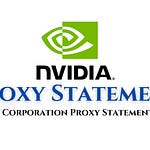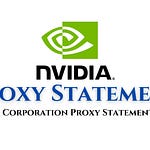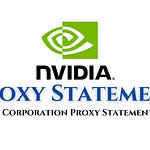NVIDIA 2025 Annual Report: Key Themes and Insights
Source: nVidia Proxy Statement for Stockholders Annual Report 2025
1. The AI Superchip Powering the Next Industrial Revolution
NVIDIA is positioning itself at the forefront of what it terms "the next industrial revolution," driven by AI. The company views its computers as the "thinking" engines of this new age.
Ubiquitous AI Adoption: AI is expected to sweep "across every market and institution—from digital customer service and drug discovery to financial trading, software development, robotics, and self-driving cars."
Tokens as the Unit of Intelligence: NVIDIA defines "tokens" as "the atomic units of digital intelligence—the symbols through which AI expresses thought. Each token is a fragment of meaning: a word, a piece of code, a strand of DNA. In sequence, they form thoughts, instructions, stories, and reasoning."
Massive AI Infrastructure Investment: NVIDIA anticipates that "trillions of dollars of AI infrastructure" will be built in the decade ahead, reshaping the global economy. This includes every company operating AI factories they built or rent, and every country building and operating AI factories as part of their critical infrastructure.
Agentic Systems and Physical AI: The report highlights the emergence of "agentic systems entering production" across various sectors. Furthermore, "physical AI" is expected to redefine work, with "everything that moves—cars, forklifts, surgical arms, warehouse bots—becoming autonomous," and "humanoid robots that can operate and work in environments made for humans making rapid advances." NVIDIA explicitly states it is "powering physical AI."
Role of AI in Addressing Labor Shortages: AI, in the form of "digital workforce of companies" and "physically intelligent robots," is projected to help "making up for the tens of millions of unfilled jobs and offsetting labor shortages around the world," leading to economic growth and increased productivity.
Blackwell Architecture: The Blackwell architecture is central to powering AI infrastructure across hyperscalers, enterprises, and sovereign clouds.
2. CUDA-X: The Language of Accelerated Computing
NVIDIA's CUDA-X is presented as the foundational software stack that enables accelerated computing and translates raw GPU power into practical solutions across diverse industries.
Software Abstraction: CUDA-X is a "layered software stack of domain-specific libraries, frameworks, and tools built on NVIDIA CUDA" designed to "abstract complexity and delivers performance."
Broad Industry Applications: It facilitates breakthroughs in a wide array of fields, including:
Materials Science (Warp Physics)
Weather Modeling (Earth-2)
Industrial Design (Computer-Aided Engineering, e.g., cuFFT, AmgX)
Data Science and Processing (cuDF, cuML)
Deep Learning (TRT-LLM, Megatron, NCCL, cuDNN, CUTLASS, cuBLAS)
Quantum Chemistry (cuEquivariance, cuTENSOR, cuQuantum, CUDA-Q)
Medical Imaging (MONAI)
Gene Sequencing (Parabricks)
Decision Optimization (cuOpt)
5G/6G Signal Processing (Aerial Sionna)
Computational Lithography (cuLitho)
Numerical Computing (cuPyNumeric)
Accessibility and Impact: The core message is that CUDA-X makes "accelerated computing accessible, powerful, and practical—transforming raw GPU capability into real-world breakthroughs."
3. Strong Financial Performance in Fiscal 2025
NVIDIA experienced significant growth in Fiscal 2025, driven largely by demand for its data center products.
Revenue Surge: Total revenue increased by "114% year on year to $130.5 billion."
Data Center Dominance: This growth was primarily "led by exceptional Data Center demand for our Hopper architecture used for large language models, recommendation engines, and generative AI applications." Ethernet for AI, including the Spectrum-X platform, was also a key contributor.
Profitability Improvement: Gross margin expanded to "75.0%," and operating income rose "147% to $81.5 billion," with diluted earnings per share also increasing "147% to $2.94."
Geographic Revenue: Sales outside the United States accounted for 53% of total revenue. While Singapore is a significant billing location (18% of total revenue), actual product shipments to Singapore were less than 2%, indicating a centralized invoicing hub.
Inventory and Purchase Commitments: As of January 26, 2025, consolidated inventories were $10.1 billion, and outstanding inventory purchase and long-term supply and capacity obligations totaled $30.8 billion, a significant increase from the prior year due to new product introductions like Blackwell.
4. Corporate Governance and Sustainability
NVIDIA emphasizes its commitment to corporate sustainability and details its governance structure and executive compensation.
Corporate Sustainability Pillars: The company aims to integrate "sound CS principles and practices into every aspect of the Company," focusing on:
Climate and Efficiency
Human Capital Management
Product Value Chain
Human Rights
Trustworthy AI
Public Policy Engagement and Accountability
Board of Directors: The Board comprises diverse expertise, including academia, technology, finance, and marketing. Jen-Hsun Huang, the founder, has served as President & CEO since 1993, pioneering accelerated computing and the GPU.
Executive Compensation: Executive compensation is tied to performance metrics, including:
Revenue (for Variable Cash Plan)
Non-GAAP Operating Income (for SY PSUs - Single-Year Performance Stock Units)
TSR relative to the S&P 500 (for MY PSUs - Multi-Year Performance Stock Units)
Fiscal 2025 Non-GAAP Operating Income and Fiscal 2023-2025 3-Year Relative TSR both "exceeded Stretch Compensation Plan goal," leading to high payouts for executives.
Shareholder Relations: The report outlines procedures for shareholder meetings, voting, and proxy submissions. It also details stock repurchase programs and cash dividend payments.
5. Regulatory Environment and Intellectual Property
NVIDIA operates within a complex global regulatory landscape and relies heavily on intellectual property protection.
"AI Diffusion" IFR Impact: A significant development is the U.S. Government's (USG) "AI Diffusion" Interim Final Rule (IFR), published on January 15, 2025. This rule imposes a worldwide licensing requirement on certain products classified under ECCNs 3A090.a, 4A090.a, or corresponding .z ECCNs, including "any system that incorporates one or more of the covered integrated circuits," such as NVIDIA DGX, HGX, and MGX systems. This includes current and future products like A100, H100, B100, and RTX 6000 Ada.
Tiered Global System: The IFR divides the world into three tiers, potentially impacting NVIDIA's long-term financial results and competitive position.
Intellectual Property Protection: NVIDIA protects its IP through a combination of "patents, trademarks, trade secrets, employee and third-party nondisclosure agreements, and licensing arrangements." The company continuously assesses where to seek formal protection based on factors like manufacturing location, strategic technology directions, and IP enforcement in different jurisdictions. Patents are set to expire between February 2025 and June 2045.













Share this post